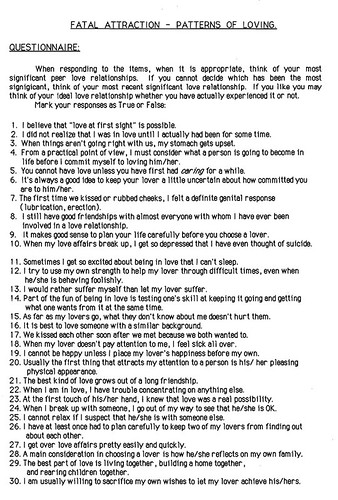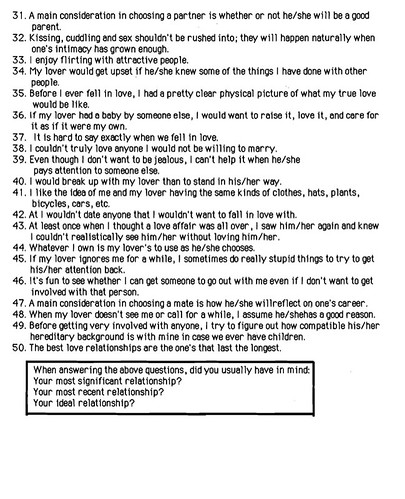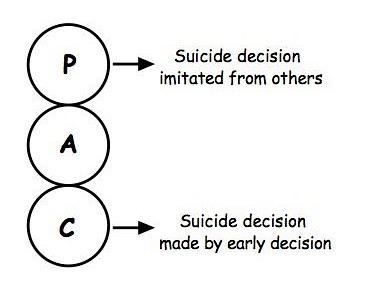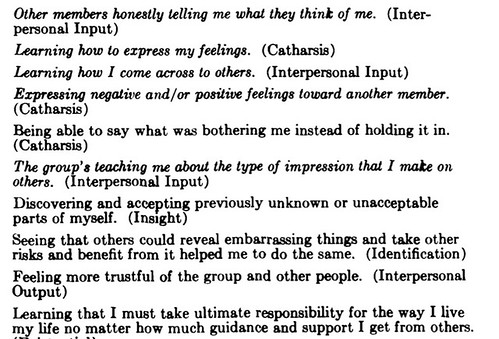Approximately 30% of people who complete a suicide leave a note of some kind. They can provide valuable insight into the psychology of the person at the point of the suicide attempt.
It must be noted that I have never met any of the individuals discussed here. As such my comments are based solely on what was written in the suicide notes and some of the circumstances know around their deaths. In no way is there an attempt to provide rigourous understanding of the psychology of these people. With the limited information at hand that is impossible. Instead I have made a few comments about what has been said in the suicide notes and these are meant to be generic in nature.
Adolf Hitler
The Last Will
As I did not consider that I could take responsibility, during the years of struggle, of contracting a marriage, I have now decided, before the closing of my earthly career, to take as my wife that girl who, after many years of faithful friendship, entered, of her own free will, the practically besieged town in order to share her destiny with me. At her own desire she goes as my wife with me into death. It will compensate us for what we both lost through my work in the service of my people.
What I possess belongs - in so far as it has any value - to the Party. Should this no longer exist, to the State; should the State also be destroyed, no further decision of mine is necessary.
My pictures, in the collections which I have bought in the course of years, have never been collected for private purposes, but only for the extension of a gallery in my home town of Linz on Donau.
It is my most sincere wish that this bequest may be duly executed.
I nominate as my Executor my most faithful Party comrade, Martin Bormann. He is given full legal authority to make all decisions. He is permitted to take out everything that has a sentimental value or is necessary for the maintenance of a modest simple life, for my brothers and sisters, also above all for the mother of my wife and my faithful co-workers who are well known to him, principally my old Secretaries Frau Winter etc. who have for many years aided me by their work.
I myself and my wife - in order to escape the disgrace of deposition or capitulation - choose death. It is our wish to be burnt immediately on the spot where I have carried out the greatest part of my daily work in the course of a twelve years' service to my people.
Given in Berlin, 29th April 1945, 4:00 a.m.
Signed: A. Hitler
Signed as witnesses:
Dr. Joseph Goebbels
Martin Bormann Colonel
Nicholaus von Below
My comments
This is interesting for a number of reasons. It illustrates that type of statement that is part suicide note and part last will and testament. These are typically like an unemotional business letter as compared to the next suicide note which is highly emotional.
This is not a good sign if one finds a loved ones suicide note that is business like it its style. Firstly it indicates the person still has well functioning cognition or thinking ability. If this is the case then they can employ that clear thinking in planning a suicide attempt in the same manner. Thus the suicide attempt is more likely to be being completed compared to the spontaneous and not well thought out suicide attempt.
Secondly it indicates this person has made the decision to end their life and it is just a matter of time until the planning is finalised and the attempt will occur. The ambivalence of “I want to die vs I don’t want to die” that most suicidal people have is not apparent. This person is clear they have made the decision to end their life.
This most often happens over an extended period of time. The individual, in this case Adolf Hitler, may have made a series of decisions over years where he slowly backed himself into a corner where the only way out, in his mind, was to end his own life. This is usually done initially at an unconscious level but can become much more conscious as the time draws closer. The person finds them self caught up in a situation created by them (and now all those around them) and can see no way of getting out of it. They suddenly realise they are on a fast moving train and can see now way of getting off.
At the beginning they cannot see where all this is heading but as they proceed on it becomes more obvious. Other examples of this can be with financial ruin. The person makes a series of decisions over a long period of time where the likelihood of financial ruin becomes more likely. Eventually it happens and they take their own life.
Some do the same with a loss of reputation. The politician or high profile person engages in what is very unwise behaviour often of a sexual nature. Eventually they are exposed and their reputation is ruined. This is same reason why pedophiles are a high risk group for suicide attempts. They behave in a way over time which significantly increases the risk of being found out. When they finally are they feel they have no way to turn, their reputation is ruined and thus they make an attempt ion their life.
The point here in the suicide note of Adolf Hitler is it reflects a business like approach to making a suicide attempt. This commonly results from a protracted set of decisions made by the person which slowly but surely backs them into a corner, such that they can only see one way out.
------------------------
KURT COBAIN (Nirvana)
To Boddah
Speaking from the tongue of an experienced simpleton who obviously would rather be an emasculated, infantile complain-ee. This note should be pretty easy to understand.
All the warnings from the punk rock 101 courses over the years, since my first introduction to the, shall we say, ethics involved with independence and the embracement of your community has proven to be very true. I haven't felt the excitement of listening to as well as creating music along with reading and writing for too many years now. I feel guity beyond words about these things.
For example when we're back stage and the lights go out and the manic roar of the crowds begins., it doesn't affect me the way in which it did for Freddie Mercury, who seemed to love, relish in the the love and adoration from the crowd which is something I totally admire and envy. The fact is, I can't fool you, any one of you. It simply isn't fair to you or me. The worst crime I can think of would be to rip people off by faking it and pretending as if I'm having 100% fun. Sometimes I feel as if I should have a punch-in time clock before I walk out on stage. I've tried everything within my power to appreciate it (and I do,God, believe me I do, but it's not enough). I appreciate the fact that I and we have affected and entertained a lot of people. It must be one of those narcissists who only appreciate things when they're gone. I'm too sensitive. I need to be slightly numb in order to regain the enthusiasms I once had as a child.
On our last 3 tours, I've had a much better appreciation for all the people I've known personally, and as fans of our music, but I still can't get over the frustration, the guilt and empathy I have for everyone. There's good in all of us and I think I simply love people too much, so much that it makes me feel too fucking sad. The sad little, sensitive, unappreciative, Pisces, Jesus man. Why don't you just enjoy it? I don't know!
I have a goddess of a wife who sweats ambition and empathy and a daughter who reminds me too much of what i used to be, full of love and joy, kissing every person she meets because everyone is good and will do her no harm. And that terrifies me to the point to where I can barely function. I can't stand the thought of Frances becoming the miserable, self-destructive, death rocker that I've become.
I have it good, very good, and I'm grateful, but since the age of seven, I've become hateful towards all humans in general. Only because it seems so easy for people to get along that have empathy. Only because I love and feel sorry for people too much I guess.
Thank you all from the pit of my burning, nauseous stomach for your letters and concern during the past years. I'm too much of an erratic, moody baby! I don't have the passion anymore, and so remember, it's better to burn out than to fade away.
Peace, love, empathy. Kurt Cobain.
Frances and Courtney, I'll be at your alter. Please keep going Courtney, for Frances. For her life, which will be so much happier without me.
I LOVE YOU, I LOVE YOU!
My comments
Unlike the previous suicide note one this is very emotional. It involves much more Child ego state compared to the Adult ego state of the previous one. This means that should a suicide attempt follow this one has less chance of being completed as there is less Adult ego state available for the planning and carrying out of the plans.
Overall it is quite a narcissistic statement. The first half is about him and at the end there is a comment to his loved ones. The comment about his daughter is that she reminds him of himself and when he talks of his wife he ends up talking about himself again. At the very end he almost apologizes for the pain he is about to inflict on his wife and daughter but does not actually do it.
This raises an interesting point about some suicidal people. At the point of a serious attempt they can be quite childlike and quite narcissist. Indeed this in itself can be a predictor of the risk of a suicide attempt. The narcissistic person is not capable of empathy and simply does not see the point of view or feelings of others. They do not get consideration which frees the person up more to act on the suicidal urges.
One of the protective factors for a suicidal person is understandig the effect that their death would have on loved ones around them. The more childlike and narcissistic the suicidal person is the less this remains a protective factor and often the person will think what he said in the second last sentence. That their death will actually be a positive for the loved ones around him.
This note is also reflective of a person who has made the “Don’t exist’ or suicide decision in childhood. It shows no signs of being an attempt to manipulate anyone and clearly this is not a spontaneous decision but is the result of circumstances that have developed over some time. As those circumstances evolve the early suicide decision starts to become operational and his suicidality increases.
---------------------
SID VICIOUS (Sex pistols)
Sid Vicious was accused of the murder of his girlfriend Nancy Spungen
A pathologist who examined his body said the star's tolerance to the drug had been weakened by his period behind bars. That, and the potency of the heroin, had killed him.
Meanwhile, Anne Beverley (his mother) discovered what appeared to be a suicide note in the pocket of her son's jeans. Written some days earlier, Vicious told his mother he wanted to be reunited with 'his' Nancy.
The discovery of the letter led some friends to speculate that Nancy's death had been a suicide pact that had gone wrong, and Spungen had administered the fatal knife wound herself.
In fact, ten days after her death, Vicious had attempted to slash his wrists, and just a few months earlier the couple had told a British music magazine of their plans to take their own lives.
Note: We had a death pact, and I have to keep my half of the bargain. Please bury me next to my baby in my leather jacket, jeans and motorcycle boots. Goodbye.
My comments
This suicide note raises some different features than the other two notes. Firstly it demonstrates the very short suicide note that is only a few lines long. This reflects a lack of desire to make some long statement about why or what is to be done upon ones death. It is simple, straight to the point, explaining why and giving instructions about what is to be done after death.
A complete lack of any emotion or remorse at the pain inflicted on others or the pain they were feeling at the time. This may be because at that time he was in quite a narcissistic frame of mind and unable to contemplate the effects of his actions on loved ones. However that may not be so. Some suicidal people report the futility of leaving a note. What can you say to make loved ones feel a bit better? What you say may just make them feel worse. One could argue that because he was very brief and gave a few instructions he has done a better thing for his loved ones than the highly emotive note shown above.
The note is clear in illustrating an intent to die and raises the whole area of suicide pacts. This is where relationships and suicide get mixed up. Many couples have a special connection with some activity, or place or belief. It may be a special activity they do each wedding anniversary once a year. Or a special place they go to on holiday each year. These things give them a commonality, a kind of special connection and is seen by both as important in their relationship. Sometimes the special thing is a belief or view about something. If we have two people who are potentially suicidal that special connection can be about suiciding together. Hence we end up with the suicide pact.
Graffiti




























